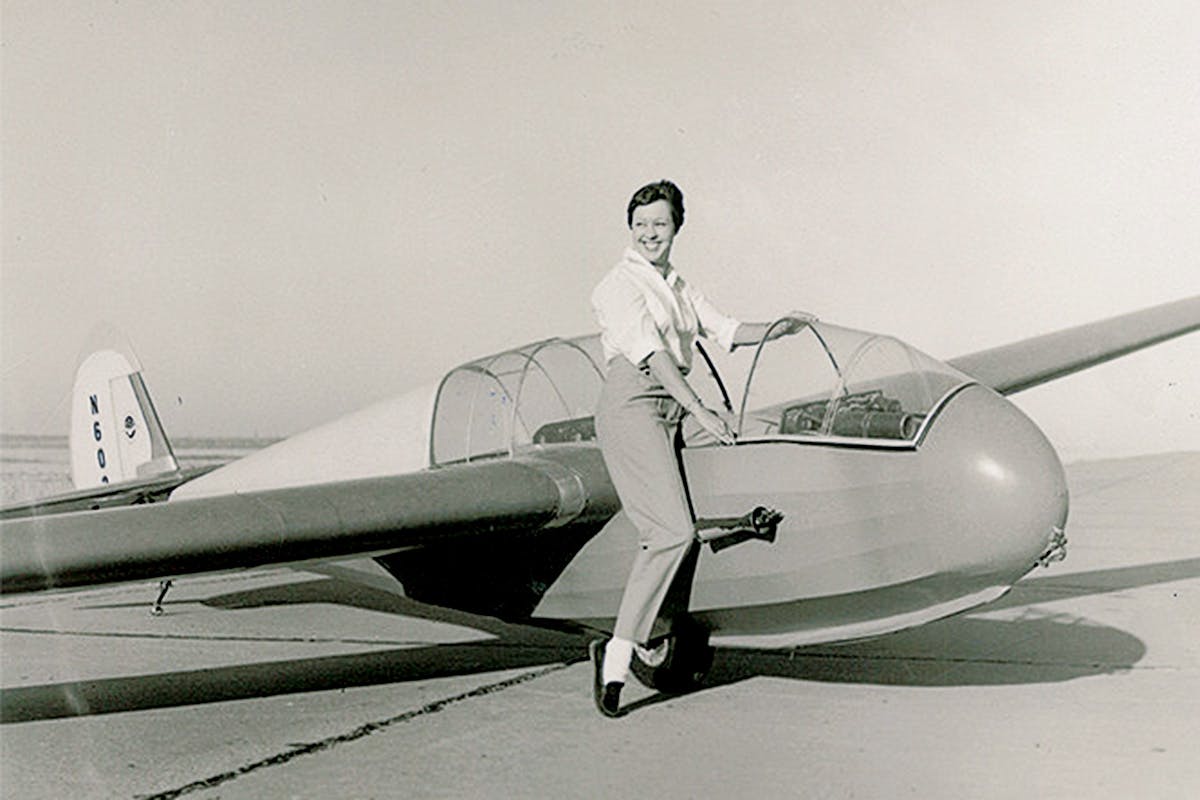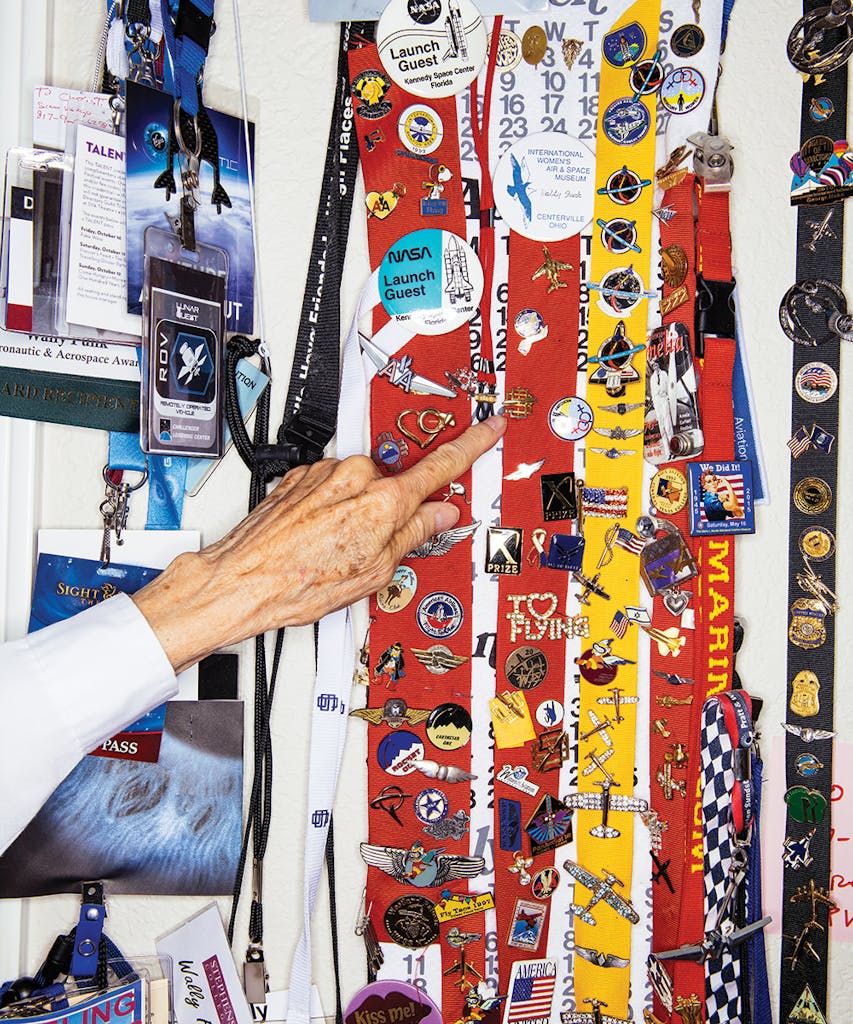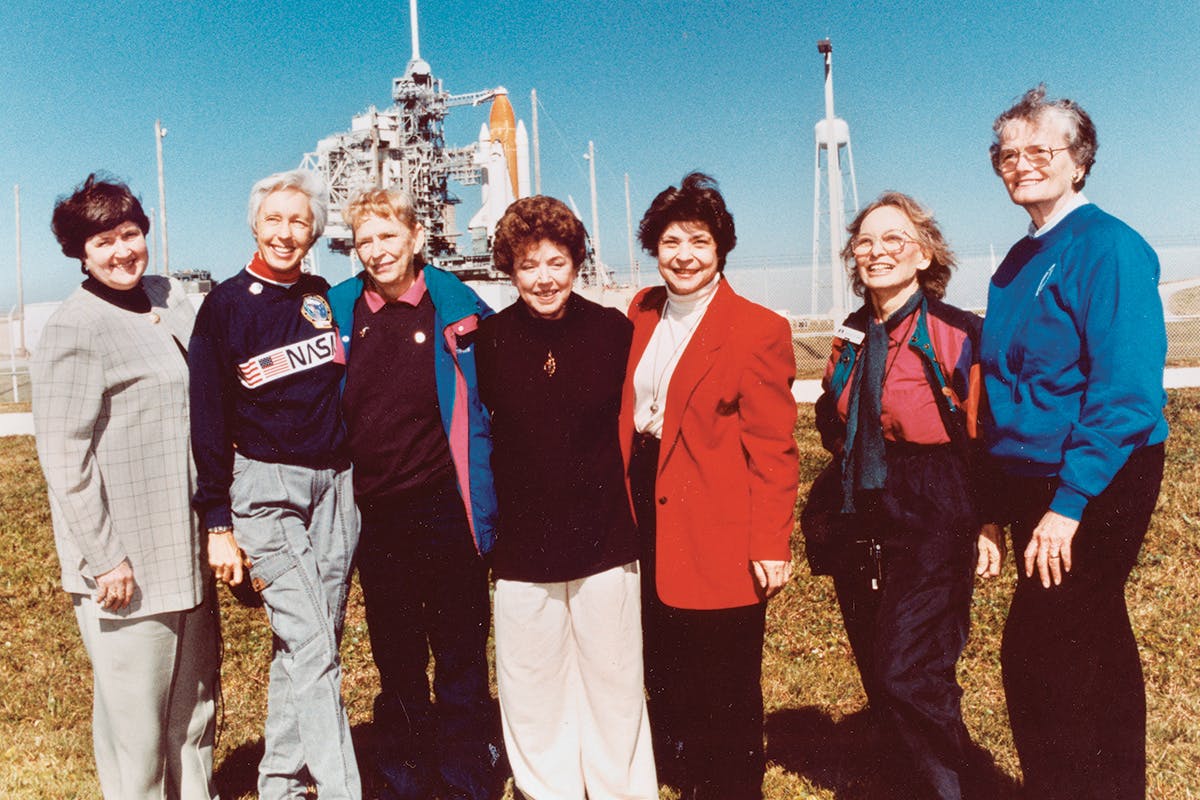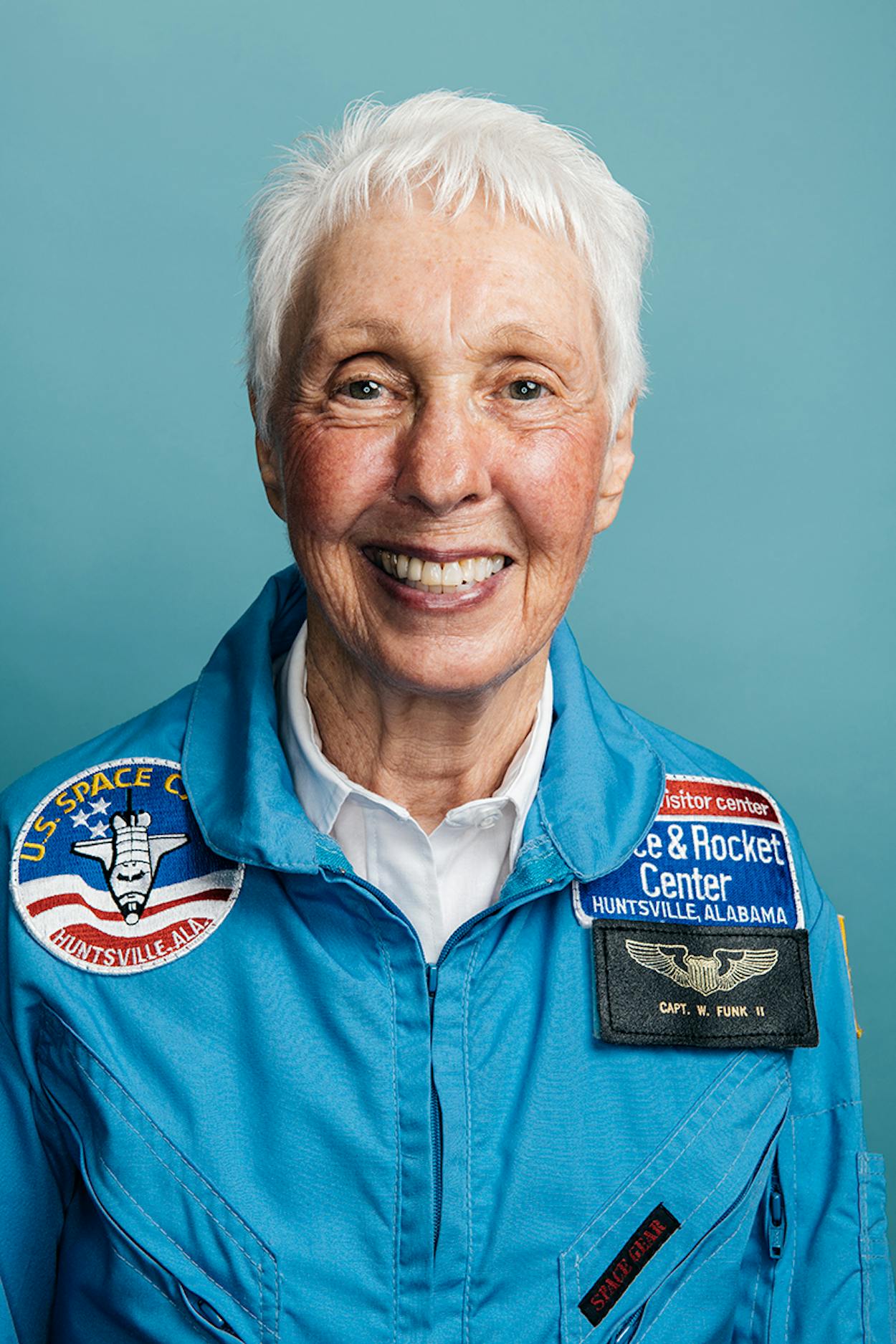It would be important to remember the time, she thinks. She looks up at the clock just before she enters the room. 8:20. She tries to burn that number into her mind. 8:20. 8:20. She knows she won’t see a clock again for a while.
In the middle of the room is a tank, eight and a half feet deep and ten feet in diameter. The water inside it is exactly the same temperature as her body, so as she steps into it, she begins to lose sense of where she ends and the water begins. She’s wearing a very modest one-piece swimsuit—it’s 1961, after all, and this is a professional setting. Behind her neck and her back are two flotation devices the size of bricks, to help her stay on top of the water without kicking her legs or fluttering her arms. Conveniently, she has short hair, so she doesn’t have to deal with a ponytail or topknot. She turns onto her back and settles in.
Once she’s fully afloat, a researcher in the adjoining room turns out the light so she can’t see anything. She can’t hear anything either; the walls of the room are soundproof, not that it’s terribly loud in the basement of the Oklahoma City Veterans Hospital. A few feet above her, a microphone suspended from the ceiling picks up her breathing. Any thoughts she wants to share with the researchers, who will be listening in from the adjacent room, will be recorded in a file for Mary “Wally” Funk, age 22.
The object of the test is to give the researchers a sense of whether Wally has the psychological makeup to withstand outer space’s dark solitude. It’s a potential deal-breaker for anyone with hopes of joining the astronaut program, but she’s not nervous. Never mind that some people who have spent time in the pool have acted strangely; they’ve hallucinated, told dirty jokes, burst into tears. The absence of input to the brain sometimes triggers it to compensate with frantic, colorful output. Extended isolation conditions are regarded as so stressful, in fact, that researchers had assumed no one could last longer than six hours—though another female test subject has broken the record by staying in this same tank for nine hours, forty minutes. (Male astronauts were subjected to something less onerous: sitting in a dark, soundproof room for up to three hours.) Wally is sure she can endure anything; she just has to prove it. She knows she’ll be all right.
Still, it’s an unusual sensation, being here. She can’t feel the difference between the water and the air; can’t tell if her eyes are open or shut; can’t hear anything save for her own breathing. She stretches her arms out, away from her sides, and relaxes.
At first, Wally thinks briefly about her parents: her father, the owner of a five-and-ten store in Taos, New Mexico, and her mother, an art enthusiast with aristocratic airs who understood that her daughter was a tomboy who’d rather ride horses and compete in marksmanship contests than bake something out of a Betty Crocker cookbook. When Wally was nine years old, a pilot let her help steer a plane and told her parents that she’d done a good job. Years later her adviser at Stephens College, in Columbia, Missouri, called up her mother and said, “Mrs. Funk, your daughter’s not doing too well in her subjects,” and her mother—bless her—responded, “Do you have an airport? You get her out there and start her flying.” Wally wanted speed! Elevation! There was a place for her in the world, right? This was the 1960s, which hadn’t yet become the Sixties, though it was already clear that things were changing.
Soon the thoughts of her parents dissipate, and she enters a liminal space between sleep and wakefulness. Her mind drifts away from everything—from her family, from her career, from the unlikely series of choices and circumstances that brought her here, to this dark room.
She breathes in. She breathes out. In. Out. She’s been in the tank for a while, though for how long she has no idea.
Which is why she’s a little surprised when the researcher gets on the intercom and says, “Wally, how are you doing?”
“I’m perfect,” she answers.
“Well, it’s time. We’re going to bring the lights up gently here. Watch where the steps are when you get out of the pool, and come on out.”
She stands up and makes her way out of the water. Remember 8:20. 8:20. Wally exits the room and looks at the clock, but the researcher has covered it. “What time is it?” she asks.
“6:55,” he answers. She has floated in silence for a record-breaking ten hours and 35 minutes.

There are many books and movies that acknowledge Wally Funk’s place in the history of the space program, such as Martha Ackmann’s 2003 history The Mercury 13: The True Story of Thirteen Women and the Dream of Space Flight and the recent Netflix documentary Mercury 13. In March a biography, Wally Funk’s Race for Space, by Sue Nelson, was published by the Chicago Review Press. But Wally isn’t shy about putting you on notice that some of the information out there is wrong—for instance, anything that challenges her version of besting everyone in the tests all the potential astronauts were put through. She’ll say she knows; she was there. So were others who remember things differently, and some of the data from those days reveals that she was bested—barely—by John Glenn in an oxygen usage test. Asked about these discrepancies, she’ll all but shrug and insist that the researchers told her that she performed better than anyone else, male or female, who had taken the tests. Regardless, one part of the story is indisputable: a group of women tried like hell to get into the space program. And another group tried just as hard to keep them out.
The men in charge of these things offered plenty of predictable reasons to deny the women a seat in a spacecraft, all of which sound silly now: women were too weak, too incompetent, too complacent, too physically “complicated.” One lab executive called them “a luxury item we can ill afford.”
But not everybody dismissed them—certainly not the key scientist studying astronauts at the time. The chairman of NASA’s Life Sciences Committee, Dr. Randolph Lovelace—the guy who administered the physical tests for the astronauts who would become the famous Mercury Seven—wanted to learn more about the female constitution. After all, women are generally lighter, which meant a rocket would require less fuel to get them into orbit. They usually eat less, which meant flights would require fewer provisions. Their reproductive systems are tucked up inside their bodies, which, it was thought, might expose them to less damage from radiation. Lovelace knew that some space administrators would balk at the idea of female astronauts and mutter squishy theories about how women became unstable when they menstruated. But he was a scientist. He wanted evidence.
So with funding from his friend, a force of nature named Jackie Cochran—then the most famous female pilot in the country, a self-promoting world record holder who’d married a wealthy businessman—Lovelace began running tests at his laboratory in Albuquerque. NASA didn’t order the study or even officially approve of it; this was a quiet, privately funded experiment. Its function was simply to investigate whether women were worth considering for the space program. Lovelace wanted the female equivalent to the Mercury Seven: healthy young women who had logged more than a thousand hours of flight time. He ruled out Cochran—apparently, problems came up on her medical exam—and began with an obvious choice, the 1959 Woman of the Year in Aviation, a 28-year-old Oklahoman named Jerrie Cobb.
Over the course of a few days, Lovelace poked and prodded Cobb to check things like liver function, blood sugar, cholesterol, night vision, depth perception, susceptibility to vertigo, and gastric and colonic health—75 tests in all. Cobb did spectacularly. Among other things, she required less oxygen than the average male astronaut. Lovelace figured he was on to something, and he wanted to prove to NASA that she wasn’t a fluke. So he started lining up other test subjects.
Wally was a pilot instructor at Fort Sill, in Oklahoma City, sitting in her apartment when she read a feature in the August 29, 1960, issue of Life magazine titled “A Lady Proves That She’s Fit for Space Flight.” It introduced Cobb, “the first prospective space pilot in a hitherto unannounced 12-woman testing program,” one who “complained less than the Mercury men had.” Cobb was photographed pedaling a bicycle ergometer, breathing into a contraption that measured lung capacity, swimming, playing tennis, and (curiously) praying. Right away, Wally knew what she wanted. She had a bachelor of science in education, she had racked up 1,300 flying hours, and she’d been named top coed pilot of the year, twice, while she was in college. She wrote Lovelace a few weeks after reading the story in Life. She wanted in.

It didn’t matter that she didn’t know much about the program or that Lovelace was improvising, taking each step as it came. When Lovelace invited Wally to Albuquerque for testing on February 26, 1961, she agreed. Of course she did. She’d be the thirteenth test subject in a group now dubbed the Mercury Thirteen that included twins Jan and Marion Dietrich, of California; Jerri Sloan, an airplane racer out of Dallas; and Janey Hart, wife of a U.S. senator from Michigan. Wally didn’t know them, hadn’t heard of them, wasn’t introduced—this was the case for most of the gals. She arrived in Albuquerque with her parents, and, with a suitcase packed for a week, she waved goodbye to them and threw her shoulders back, walked up to the four-story building that housed Lovelace’s lab, and introduced herself to the staff.
Testing was about as intrusive as anyone would expect, not that it bothered her. There were sinus X-rays, stool samples, rectal and pulmonary exams, and tests that required her to swallow three feet of rubber tube and endure ice water blasting into her ears. She passed all of them.
But the study didn’t end there. By the summer, Cobb had found a place in Oklahoma City where Wally and the rest of the group could take the next round of tests, which focused on the mind. The isolation tank was perhaps the most significant of those tests. Before Wally entered the tank, the researchers conducted a psychological evaluation: they asked her questions about her childhood and her parents and her hobbies. She loved opera—especially Verdi’s Nabucco, she said—and had played drums in the high school orchestra, which was one of the few things that even came close to the joy of executing rolls and loops in a Boeing Stearman. After she completed the isolation tank test, they asked her, “Do you still want to go into space?” You can imagine her answer to that.

It didn’t happen, of course. Not then. Even after Cobb and another female candidate testified before the House Committee on Science and Astronautics in the summer of 1962, arguing that qualified women were being discriminated against. “There were women on the Mayflower and on the first wagon trains west, working alongside the men to forge new trails to new vistas,” Cobb told the committee. “We ask that opportunity in the pioneering of space.”
But John Glenn, a member of the Mercury Seven who just months earlier had become the first American to orbit the earth, seemed to put the matter to rest in his testimony. “It is just a fact,” he said. “The men go off and fight the wars and fly the airplanes and come back and help design and build and test them. The fact that women are not in this field is a fact of our social order.” Glenn, who had himself gone through Lovelace’s testing regimen and no doubt knew how difficult it was, acknowledged that perhaps this strict division of gender was an “undesirable” state of affairs. Some indifference was implied. He didn’t oppose a program to train women astronauts. Then again, he added, “I see no requirement for it.”
American women wouldn’t get into space for another two decades, when Sally Ride flew on the Challenger shuttle’s second mission, in 1983. And sixteen years later, when Eileen Collins became the first female shuttle commander, a group of surviving Mercury Thirteen women, including Wally, were her personal guests at the launch. “They gave us a history,” Collins said. She had to know how much that meant to the older women.
Still, Wally wasn’t one to give up easily. That’s how she’s managed to accomplish anything in this world. After Lovelace’s studies ended, Wally became the first female Federal Aviation Administration safety inspector. She was the first woman in the FAA’s Systems Worthiness Analysis Program and one of the first “girl inspectors” (her words) to work with the National Transportation and Safety Board. She taught hundreds of students how to fly and presented seminars and keynote speeches across the world. She didn’t make it to space. But she found her way.

These days, living in Grapevine, at an age that she doesn’t want to reveal (but you can do the math), she is still determined to get to space. She’ll happily dig through her files to show you the paperwork that indicates that she will ride Virgin Galactic’s SpaceShipTwo, a commercial suborbital spaceship in development that is expected to fly as high as 62 miles—an elevation known as the Kármán line, which is regarded as the border between Earth’s atmosphere and outer space. She’ll pull out her two canceled checks for $100,000 each that she used to pay for the ticket nine years ago. She’ll show you the photographs of herself with Virgin Galactic’s founder, Richard Branson. She’ll tell you about her trips to visit the Mojave Air and Space Port, in California, and Spaceport America, in New Mexico, where Virgin Galactic parks and tests the vehicles. Ticket holders like her gather there to discuss their future trips on SpaceShipTwo and look at diagrams of where the two pilots and six passengers will sit. She’ll pull out a model of the craft and point to the spot where she’d sit: right up front, behind the first officer, in the first row. Despite the fact that dozens of people are ahead of her in line, she remains hopeful. Recently, she says, the company sent her an email asking about her suit size.
She knows what it will be like, too. “At takeoff,” she explains, “I’ll be sitting way back in my seat, and I’ll see things going by me. And then we get up to about ten thousand feet or forty thousand feet and climbing. I doubt it would be a steep climb. I imagine it would be about a thirty-degree climb. And then we get into weightlessness, and we’re floating.” Before SpaceShipTwo begins its descent, it will hover for about five minutes so everyone can take in the black sky and the thin band of light that traces the curvature of the earth.
Ever since the day she spent in that dark room in Oklahoma City decades ago, Wally has laid down in bed the same way every night, her arms stretched away from her sides, as they were when she was drifting in the tank. She says it helps her sleep better. But perhaps there’s more to it than that. Maybe this is what it’s like, in zero gravity, in space. Everything’s quiet. The bed recedes beneath her, and she rises up, up, up.









